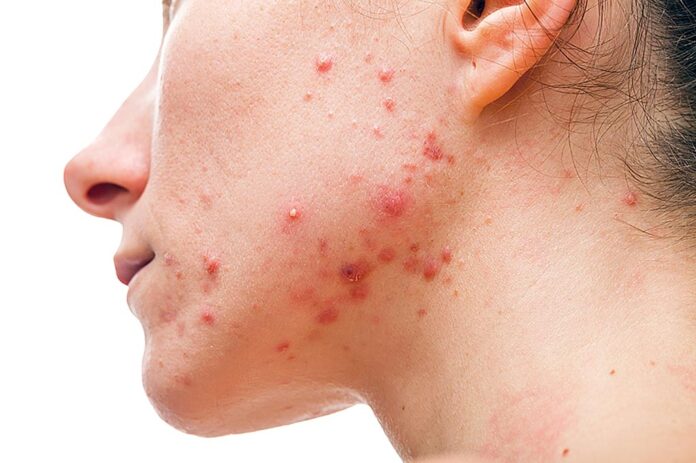Acne is a chronic inflammatory skin disease that can cause severe distress to those who are affected with this condition. Acne often starts after puberty when hormones levels increase leading to the production of more sebum (oil) by the skin’s sebaceous glands. When sebum gets trapped within the pores by a protein substance made by the skin cells called keratin, the conditions are present for p. acnes bacteria to react with the sebum and cause the inflammation seen in acne. Face masks introduce heat, friction and a covering that creates a moist environment, conditions that can worsen clogged pores, hence the recent surge in “maskne.”
The treatment of acne typically starts with over the counter and/or prescription topical agents such as Differin, Retin-A, benzoyl peroxide, salicylic acid, azaleic acid, as well as antibiotics. For women birth control pills and a hormone blocking medication called spironolactone are also an option. For people who have not responded adequately to routine treatments for acne, other options are available.
Light chemical peels consisting of various acids such as salicylic, retinoic, lactic, mandelic, trichloroacetic acid, and glycolic acid determined by skin type and concern can be used for the treatment of acne by unclogging pores. Deeper peels can be used to address issues such as acne scarring but can carry higher risks.
Isotretinoin (Accutane®), a vitamin A derivative, is a powerful oral medication approved for severe, scarring acne usually prescribed for 4-6 months under a doctor’s supervision. Sometimes referred to as the “nuclear option,” it can improve acne in up to 90% of people, while at the same time having the potential for causing severe, sometimes permanent side effects such as loss of night vision, damage to internal organs, bones and joints. It is absolutely contraindicated in women who are pregnant or may become pregnant due to the risk of causing miscarriage and birth defects.
Various lasers such as Pulsed-dye lasers, Potassium Titanyl phosphate lasers, and Infrared lasers can be used for treating acne by reducing acne bacteria, sebum production and inflammation. Because laser therapy–particularly stronger lasers–may permanently damage skin oil glands, there is concern that this might potentially cause unintended long-term consequences like skin dryness and premature aging. Cost range between $1800-$2400 for a series of treatments.
IPL (intense pulsed light) and BBL (broad band light) systems that are equipped with a blue light filter can help to clear acne. The Forever Clear BBL is a system that uses a three-step process. In the first step, a blue BBL light is used to target and destroy p.acnes bacteria within the pores. The second step uses a yellow BBL light to reduce inflammation and redness associated with acne lesions. For the final step, skin is treated with infra-red light to initiate the body’s natural healing process. Cost range between $600 and $1200 for a series of treatments.
Finally, Photodynamic Therapy is another option for people who suffer from severe acne, including cystic acne. Studies show an average of 60% reduction in acne, and results appear to last for months or longer. During PDT, a light sensitizing liquid is applied to the skin and allowed to sit, then a light device is used treat the skin. PDT can be painful and have more severe side effects than traditional light therapy. Cost range between $1200 – $2400 for a series of treatments.























